There’s something magical about the moon. Putting the moon in a photograph adds a sense of mystery and timelessness, and can elevate an otherwise ordinary scene into something special. Ansel Adams confessed to being “moonstruck,” and I suppose I am too.
The moon will be full next Tuesday (at 1:28 a.m. here on the west coast), and I’m sure many photographers will be trying to capture a rising or setting moon during the coming days, so I thought I would share some ideas about photographing the full moon, and clear up some misconceptions.
Misconception #1
One misconception is that moonrise or moonset photos are taken at night. They’re not: they’re almost invariably made near sunrise or sunset. After dark the contrast between the moon and the landscape is too great, and a good exposure for the moon will make the landscape completely black, while a good exposure for the landscape will wash out the moon. Around sunrise and sunset it’s possible to balance the light between the moon and the landscape and get detail in both, yet have a dark enough sky for the moon to stand out clearly.
Misconception #2
Another misconception is that moonrise or moonset photos are made on the date when your calendar says “full moon.” This can work if the terrain is flat, or you’re at a high vantage point. But if there are mountains or ridges blocking your view of the horizon, you’re better off photographing a moonrise one to three days before the full moon, and a moonset one to three days after the full moon. While the moon won’t technically be full, it will look full enough, and be in a better position than on the actual full moon night. Here’s why:
Understanding the Moon’s Movements
A full moon is frontlit. During it’s 28-day orbit around the earth, the moon has swung around to the side opposite the sun, so as we view the moon, the light from the sun is behind us, illuminating all of the moon’s surface.
So by definition a full moon is on the exact opposite side of the earth from the sun. That means that, from our perspective on earth, the full moon rises when the sun sets, and sets when the sun rises. But one day before it’s full, the moon rises, on average, 50 minutes earlier, or 50 minutes before sunset. Two days before it’s full, the moon rises approximately 1 hour and 40 minutes before sunset. So on the days before it becomes full, the moon has a chance to rise above mountains and ridges to the east before the sun sets to the west, and you can find balanced lighting between the moon and the landscape. On the full moon date the moon usually rises too late, so by the time it’s visible the landscape below is too dark, and it’s difficult or impossible to get a good exposure for both.
One day after it’s full, the moon sets, on average, 50 minutes after sunrise. Two days after it’s full the moon sets about 1 hour and 40 minutes after sunrise. So on these days it’s possible to see the moon still hanging above the landscape to the west as the sun is rising to the east, and, again, get that balanced lighting.
Now I said that the moon rises and sets approximately 50 minutes later each day, but that interval varies greatly depending on the time of year and the stage of the moon’s orbit. The interval can be as short as 30 minutes or as long as 1 hour and 10 minutes.
Why Winter is the Best Time to Photograph a Moonrise From Yosemite Valley
The moon also changes it’s path from summer to winter. Most people know that in summer, in the northern hemisphere, the sun rises further to the north (east-northeast), travels on a high path through the sky, and sets further to the north as well (in the west-northwest). In winter, the sun rises and sets further to the south, so it rises to the east-southeast, sets to the west-southwest, and takes a low path through the sky.
While a new moon takes a similar path to the sun, the full moon does the opposite: in summer, the full moon rises to the east-southeast, sets to the west-southwest, and takes a low path through the sky. In winter, the full moon rises to the east-northeast, sets to the west-northwest, and takes a high path through the sky.
Why is this? You probably remember learning that the earth’s axis is tilted, so in summer the northern hemisphere is tilted toward the sun. But again, the full moon is on the opposite side of the earth from the sun. So in summer, in the northern hemisphere, the earth’s axis is tilted toward the sun, but away from the full moon. Because the axis is tilted away from the moon, the moon takes a low path through the sky, similar to the winter sun. And in winter, when the northern hemisphere is tilted away from the sun, it’s tilted toward the full moon, so the moon takes a high path through the sky, just like the summer sun.
This is why winter is the best time to photograph the full moon rising above Yosemite Valley. In winter, the full moon rises to the east-northeast, which lines up perfectly with the valley’s west-southwest to east-northeast orientation, and puts the moon next to Half Dome from many vantage points. In summer, the full moon rises behind the valley’s southern wall, and is hidden from most viewpoints until it gets high in the sky.
Photographer’s Helpers
All of these astronomical gyrations can get quite complex, but luckily there are some tools to help you figure all this stuff out. A new one is an app called PhotoPills. It’s excellent, but only available for the iPhone (so far). The Photographer’s Ephemeris has been the gold standard for this type of program for years. TPE is free for the desktop, and $8.99 for iOS or Android. Both PhotoPills and The Photographer’s Ephemeris are great tools for figuring out not only when and where the moon will rise, but whether it might be high enough to clear a ridge or mountain before sunset. There are excellent tutorials on both the PhotoPills and TPE websites, and if you want to capture a moonrise or moonset it’s worth learning how to use one of these programs.
Since the moon will be full during the wee hours on this coming Tuesday, the actual full moon night is Monday night, not Tuesday. So that should mean that the best evenings for photographing the rising moon in Yosemite Valley would be Saturday and Sunday. Looking at TPE confirms this. On Saturday evening the moon should rise to the left of Half Dome from locations in the eastern end of Yosemite Valley, like Cook’s Meadow, or near Sentinel Bridge. Sunday could be a good night to photograph the rising moon from Valley View or Tunnel View.
I hope this little astronomy lesson helps you understand the moon’s movements. Once you wrap your head around some of these concepts it’s not that difficult to predict when and where the moon will rise so you can put yourself in the right position to capture a moonrise or moonset. Good luck!
— Michael Frye
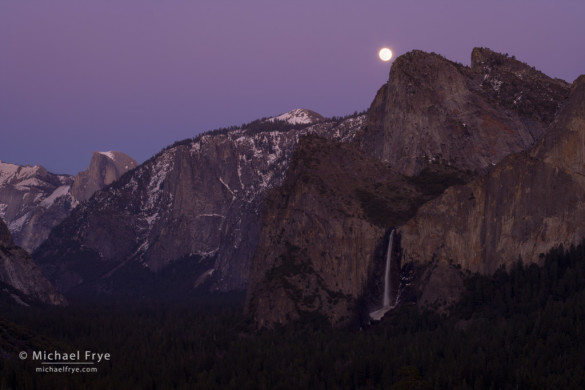
Moon rising over Cathedral Rocks from Tunnel View, February 24th, 2013. On this February evening the moon had already swung more to the right (south), away from Half Dome. As winter moves into spring and summer, the full moon rises further and further to the right.
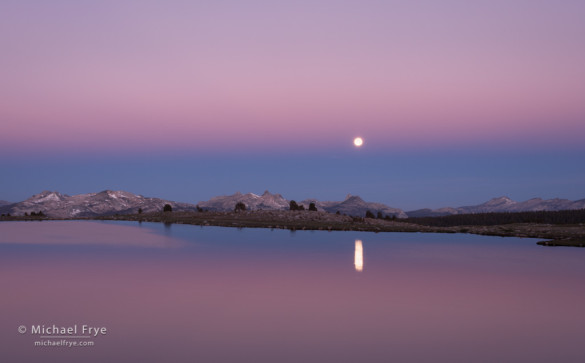
Moon setting over an alpine lake, Yosemite NP, June 23rd, 2013. Here, in summer, the moon was setting to the west-southwest. The image was made only an hour after the moon was at its fullest, but since the image was made from a high vantage point with such a low, open horizon to the west, the moon was still visible just before sunrise.
Related Posts: A Memorable New Year’s Eve; Under a Full Moon; Moonrise and… Moonrise Again
Did you like this article? Click here to subscribe to this blog and get every new post delivered right to your inbox!
Michael Frye is a professional photographer specializing in landscapes and nature. He is the author or principal photographer of The Photographer’s Guide to Yosemite, Yosemite Meditations, Yosemite Meditations for Women, and Digital Landscape Photography: In the Footsteps of Ansel Adams and the Great Masters. He has also written three eBooks: Light & Land: Landscapes in the Digital Darkroom, Exposure for Outdoor Photography, and Landscapes in Lightroom 5: The Essential Step-by-Step Guide. Michael written numerous magazine articles on the art and technique of photography, and his images have been published in over thirty countries around the world. Michael has lived either in or near Yosemite National Park since 1983, currently residing just outside the park in Mariposa, California.

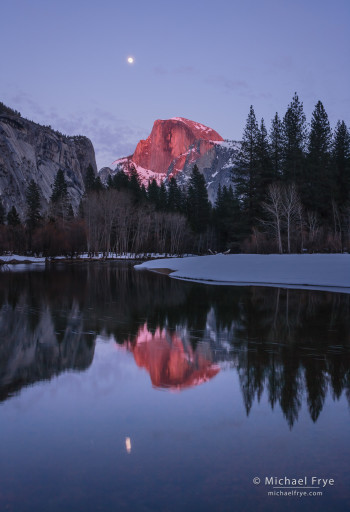
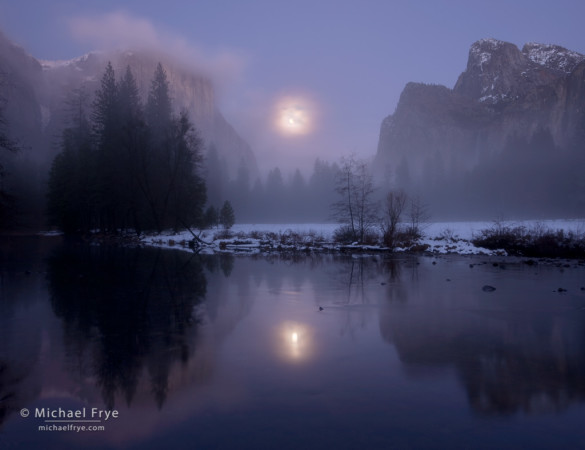
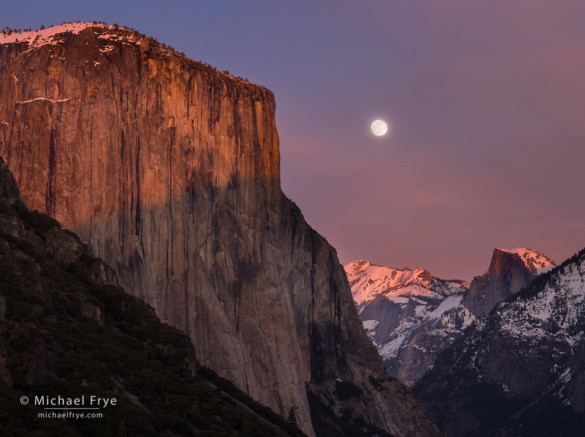








Excellent post! Makes me want to be somewhere lovely for this weekends moonrise, but major rain here, it seems. Beautifully illustrated with your very fine images, as well! Thank you!
Thank you Kenny! And although you might not see the moon, rain can make for good images.
I’ve always had trouble photographing the moon… And now I know why! Very informative! I’m eager to try again using your suggestions.
Glad you found that helpful David!
Thanks Michael, a very helpful post, and the link to TPE.
Something I intend to do but have never known how to plan for…until now!
You’re welcome Tim, and thanks!
Great post! Thank you!
Thanks AP!
Thanks so much for the reminder for this weekend. I sure like that misty Valley View shot. It’s so unique.
The other app I’ve used for tracking the moon is your own. I’ve used it several times for shooting in the Valley, and it’s especially nice that you don’t need an internet connection to use it.
We drove to the Valley and I got this shot because of your app.
http://www.flickr.com/photos/43044499@N05/8218269323/in/photolist-dwdM9F
Thanks for the plug Kevin. 🙂 And a very nice moon photo.
How timely, thank you Michael. Have been planning for the past year to get a full moon over SF bay this month. As you said, the rising moon “appears” to come north in the winter and I want to shoot a pano from the Bay Bridge to South San Jose from Windy Hill. I need the lights on in the cities by the bay and yet keep the Moon relatively low in the sky – just above the east bay hills. Have done this twice before and there is a window of time in which I get a nice moon reflection on the bay. The date and window of time on that day is critical – it only lasts for about 15-20 minutes. It takes about 20 shots to cover the distance for my pano. So, preparation is critical. When I’ve done this before I’ve either been on the wrong day or a bit late in the day, so I wasn’t in the window. Only really a couple of days each year to get this shot – and only about 20 min on those days!
Love your work – and you are so generous with your teaching in your blogs – really appreciate that.
– Greg
Thank you Greg, and good luck with your panorama!
Lovely shots and really good post. Thanks for sharing all the technical info on the good times for taking pictures of the moon, it made really good points I can use.
You’re welcome Oscar, and thanks!
Interesting and helpful information on photographing the moon. And, absolutely gorgeous images … very inspiring!
Thank you Denise!
Beautiful photos, and great write-up!!
Thanks very much Patti!
As I’m sure you would agree, any moon phase has its place at sunrise or set: http://tomstybrphotography.zenfolio.com/p844731565/e6293539C
There are more than a few angles in Yosemite.
Yes Tom, I do agree. Yosemite it unusual because of its extreme topography, which means that you can sometimes juxtapose the moon with a rock formation even when the moon is high in the sky.
Michael, excellent teaching points and fantastic images! This will be very useful information in planning moon shots.
Is it possible to obtain a “starburst” pattern of the moon in such landscapes without the use of a cross screen filter? I don’t recall ever seeing one.
Thank you James! By a “starburst pattern,” I’m guessing you mean a ray pattern on the moon itself? I’m sure this is possible, but that effect is actually a type of lens flare, so the moon would have to be very overexposed, and you’d also have to be stopped down to f/16 or f/22, just as you need to stop down to create that effect with the sun.
Your guess is correct in that the effect is a ray pattern. I suspected that the moon would have to be very bright or overexposed to obtain such an effect which would require a long exposure at stopped down apertures. Thank you for your response! I may have to try to do this on a very dark, almost full moon night!
And a Merry Christmas to you and yours!
Merry Christmas to you James!
Remember that you would need to keep exposure times pretty short so that the moon doesn’t move to much.
Excellent and very informative post Michael! A rising moon makes an even more atmospheric photo than the rising sun!
Recently i came across this application, Sun surveyor lite, for android, i think there is a version for iOS as well
https://play.google.com/store/apps/details?id=com.ratana.sunsurveyorlite
there is a pro version but the lite (free) version is a pretty and handy tool to use while being away from a computer
Thanks Ilias for the kind words, as well as the info about the Sun Surveyor app. I haven’t used it, but it looks helpful. One thing that it doesn’t seem to have, which both The Photographer’s Ephemeris and PhotoPills have, is a way to find the angle of declination of a ridge or mountain from a certain viewpoint, and determine whether the moon or sun would be above or below that ridge or mountain at a certain time. That’s very helpful.
Great Michael. I always love your posts.
I may attempt to find a spot to try my hand at photographing the moon along with the surrounding landscape… I fell for misconception 1 thank you for bringing that out.
I may get out.. but it will be -10 here in upstate NY
Thanks James! Good luck in the cold. 🙂
I have tried on purpose to shoot a moonrise after sunset just to get backed out silhouettes of Oak trees in the face of the moon. Using a 600 mm lens which takes perfectly focused moon pics when it is high in the sky. However, at moonrise I get only poorly focused photos. What settings would you suggest including ISO, shutter speed, f stops. Thanks, I am just frustrated.
Bryan, my guess is that you’re focused on the trees, which is why the moon is out of focus. The 600mm lens has very limited depth of field, so it will be difficult to get both trees and moon in focus unless the trees are quite far from you. If the trees are close you’ll need to stop down to f/22, and focus carefully, but even that might not be enough. Your best chance of getting both trees and moon in focus is to focus between the trees and moon, so that when you’re looking through the viewfinder they both look about equally out of focus. I explain this technique in The Photographer’s Guide to Yosemite book and app, in my Digital Landscape Photography book, and briefly in the Landscape Photography Show Google+ hangout I did last week. If you’re using a tripod then 100 ISO is fine, and the shutter speed at f/22 will probably be around 1/15th sec., but check your histogram and blinkies.
Thank you for all of the info in your very quick response. I intend to give this a go tonight. Looking forward to reading all of your books.